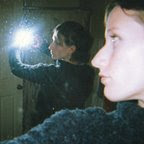Due to the complexity and smallness of the organelles inside the cell, I thought I should devote a whole tab in the interactive to describing them visually. I decided to start with an organelle that I expected to be easy: the mitochondrion. It turns out, since the late 1990's, there has been a revolution in the way that people think of mitochondria.
In the 1950's, the transmission electron microscope became a fashionable tool for inspecting cells, and it allows extremely high resolution, but the problem is that it can only examine a very thin slice of the cell. A problem arose when trying to determine the 3D structure from 2D information. There were two cytologists who were simultaneously trying to describe mitochondria. Dr. Sjostand had a more painstaking tissue fixation technique, while Dr. Palade didn't believe that the conditions of fixation were important. Their observations led them to different conclusions about the morphology of mitochondria. Dr. Sjostand insisted that the foldings of the inner membrane (called cristae) were only continuous with the rest of the membrane in very small areas, while Dr. Palade beleived that they were like the baffles of an accordion, and were continuous with the inner membrane over large spaces.
While they both agreed that Dr. Sjostand's micrographs were better, and Dr. Sjostand's fixation method has become universally adopted, Dr. Palade's baffle model was the one to become widely accepted, and it is still in most textbooks today. It wasn't until the late 1990's, when microscopy techniques were developed that allowed the examination of thicker slices of cells, that people noticed that mitochondria look nothing like Dr. Palade's model, and Dr. Sjostand was more correct about mitochondrial internal structure. The cristae are tubular in the cells of almost all tissues, and are indeed only connected to the inner membrane by small round openings, now termed "crista junctions."
But what about the external structure and overall morphology? Better microscopy has revealed that mitochondria are not usually isolated, bean-shaped entities, floating in the cytosol, but that they form a dynamic network of interconnected mitochondria that are constantly coming together and separating, based on energy demands of the cell. Also, they associate closely with the endoplasmic reticulum.
Because this information about mitochondria took me by surprise, I have decided that a good deal of reading must be done before I can draw any organelle, because I want my interactive to have the most up-to-date and accurate pictures, and not to show the generic, formulaic representations that I have been seeing all my life. So, don't be surprised if you see something represented in a way that you are not used to seeing it.
The interactive will be online soon, although this business with the mitochondria and other organelles has slowed me down somewhat...But I think it is better to do more research and invest more time in the beginning, than to have to go back and make changes later.
Jan 23, 2009
Subscribe to:
Post Comments (Atom)

No comments:
Post a Comment